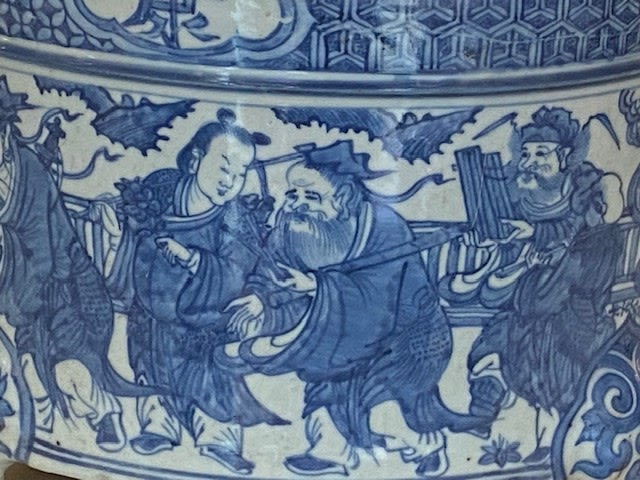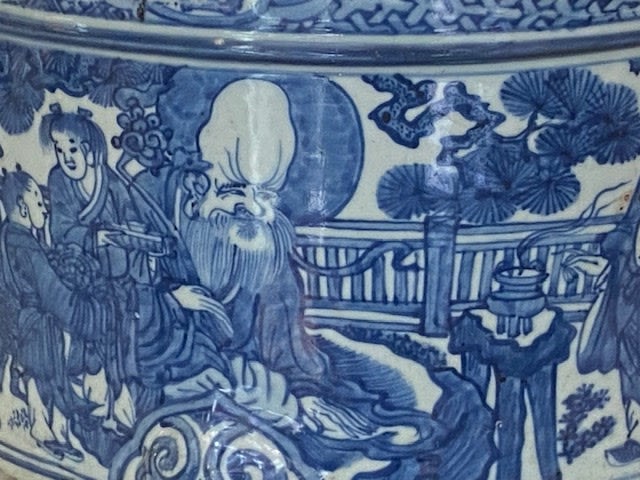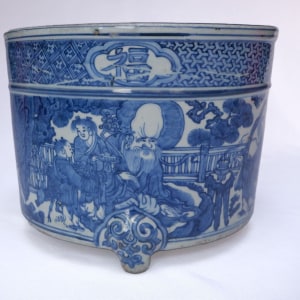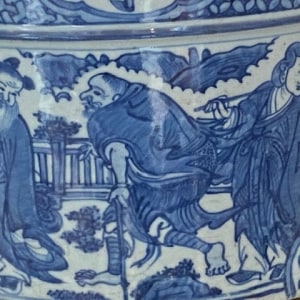A LARGE IMPOSING CHINESE MING BLUE AND WHITE 'EIGHT IMMORTALS' TRIPOD CENSER, Wanli (1572 - 1620)
28cm diameter x 19.5cm high
BH68
BH68
Further images
Stoutly potted, the wide cylindrical body decorated in shades of underglaze blue, painted to the exterior with a dynamic scene of the the Eight Daoist Immortals led by Zhongli Quan;...
Stoutly potted, the wide cylindrical body decorated in shades of underglaze blue, painted to the exterior with a dynamic scene of the the Eight Daoist Immortals led by Zhongli Quan; followed by Li Tiegui leaning on an iron crutch, Zhang Guo Lao with a bamboo drum and sticks; Lan Ciahe carrying flowers; Lu Dongbin bearing a vase with a sword strapped across his back; Han Xiangzi playing a flute; He Xiangu carrying a fly whisk across her shoulder; and Cao Guo Qiu with his castanets; the Star God of Longevity, Shou Lao, is depicted seated on a flat-topped rock accompanied by a deer and attendants, holding a 'wish-granting' ruyi sceptre, all surrounded by pine trees within a terraced garden, below a band of cartouches enclosing auspicious words of Fu Shou Kang Ning reserved on a diamond and circle pattern ground, the vessel supported on animal mask feet.
Provenance
The collection of Hon. Lady Evelyn Margaret Lindsay Mason (1870-1944) and by family descent.Literature
The inscription fu shou kang ning which translates as "wealth, longevity, health and composure". This inscription is a reference to the "Five Blessings" (wufu) first mentioned in the ancient Chinese classic known as the "Book of History".The Eight Immortals and their Attributes:
1. Zhongli Quan, Zhou dynasty, 1122- 1249 B.C., chief of the Eight Immortals, who had the secret of the elixir of life and powers of transmutation, is depicted as a fat man sometimes holding a peach in his hand and always grasping his emblem, a fan, which is said to be capable of resuscitating the souls of the dead.
2. Zhang Guolao, 7th/8th century A.D., was a recluse who had supernatural powers of magic such as rendering himself invisible. He is usually depicted with a white mule which he rode backwards over great distances, and, when not required, was folded away and put in his wallet. When he wished to resume his travels he squirted some water on the wallet and the mule at once appeared. His emblem is a You Gu, a kind of musical instrument in the shape of a bamboo tube or drum with two rods to beat it.
3. Li Dongbin, circa 750 A.D., a scholar or recluse, he learned the secrets of Daoism from Zhongli Quan. He is the patron saint of the barbers and is also worshipped by the sick and is able to rid the world of evils. His emblem is a sword which is used for dispelling evil spirits.
4. Cao Guo Qiu, 930-999 A.D., son of a military commander and brother of the Empress Cao of the Song Dynasty. He is patron saint of the theatrical profession. His emblem, the castanets, which symbolise revival, are said to be derived from the court tablet, authorising free access to the palace, to which he is entitled owing to his birth.
5. Li Tieguai is represented as a beggar leaning on an iron staff with a pilgrim's gourd. Due to his magic powers he spent much time in spirit in the celestial regions, leaving his body, apparently dead, in charge of his disciple. Once when he was absent longer than usual, having to go and take care of his sick mother, his servant decided that his master was really dead this time and buried the body. When the soul of Li Tieguai returned, he found that he had no body into which to enter, so he entered into the body of the first good person he could find, a lame beggar. His emblem is a gourd which is said to contain all kinds of magical cures.
6. Han Xiangzi is credited with the power of making flowers grow and blossom instantaneously. His emblem is the flute and he is the patron saint of musicians. He wandered the country charming the birds and the beasts with his music. He had no idea of the value of money, and when given any he used to scatter it on the ground.
7. Lan Caihe, 700 - 800 A.D. Variously stated to have been a woman and a hermaphrodite. Lan Caihe is represented as dressed in a long gown and wandered the country waving a wand and denouncing this fleeting life and its delusive pleasures. The emblem is the flower-basket which is carried, and Lan Caihe is patron saint of the florists.
8. He Xiangu was the daughter of a 7th century A.D. shopkeeper of Lingling, Hunan. Having eaten the supernatural peach, she became a fairy. She wandered alone in the hills and lived on a diet of crushed mother of pearl and moonbeams. Her emblem is the lotus and she is sometimes portrayed as standing on a lotus petal holding a fly whisk in her hand.










